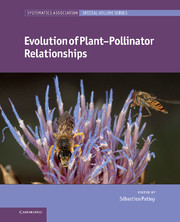Book contents
- Frontmatter
- Contents
- Contributors
- Preface
- 1 Macroevolution for plant reproductive biologists
- 2 Pollination crisis, plant sex systems, and predicting evolutionary trends in attractiveness
- 3 Evolution and ecological implications of “specialized” pollinator rewards
- 4 Fig–fig wasp mutualism: the fall of the strict cospeciation paradigm?
- 5 Fossil bees and their plant associates
- 6 Pollen evidence for the pollination biology of early flowering plants
- 7 Pollinator mediated floral divergence in the absence of pollinator shifts
- 8 Animal pollination and speciation in plants: general mechanisms and examples from the orchids
- 9 Why are floral signals complex? An outline of functional hypotheses
- 10 A survey on pollination modes in cacti and a potential key innovation
- 11 Zygomorphy, area, and the latitudinal biodiversity gradient in angiosperms
- 12 Ambophily and “super generalism” in Ceratonia siliqua (Fabaceae) pollination
- 13 Structure and dynamics of pollination networks: the past, present, and future
- 14 Pollinators as drivers of plant distribution and assemblage into communities
- 15 Effects of alien species on plant–pollinator interactions: how can native plants adapt to changing pollination regimes?
- 16 Pollen resources of non-Apis bees in southern Africa
- 17 Advances in the study of the evolution of plant–pollinator relationships
- Index
- Plate section
- References
12 - Ambophily and “super generalism” in Ceratonia siliqua (Fabaceae) pollination
Published online by Cambridge University Press: 05 January 2012
- Frontmatter
- Contents
- Contributors
- Preface
- 1 Macroevolution for plant reproductive biologists
- 2 Pollination crisis, plant sex systems, and predicting evolutionary trends in attractiveness
- 3 Evolution and ecological implications of “specialized” pollinator rewards
- 4 Fig–fig wasp mutualism: the fall of the strict cospeciation paradigm?
- 5 Fossil bees and their plant associates
- 6 Pollen evidence for the pollination biology of early flowering plants
- 7 Pollinator mediated floral divergence in the absence of pollinator shifts
- 8 Animal pollination and speciation in plants: general mechanisms and examples from the orchids
- 9 Why are floral signals complex? An outline of functional hypotheses
- 10 A survey on pollination modes in cacti and a potential key innovation
- 11 Zygomorphy, area, and the latitudinal biodiversity gradient in angiosperms
- 12 Ambophily and “super generalism” in Ceratonia siliqua (Fabaceae) pollination
- 13 Structure and dynamics of pollination networks: the past, present, and future
- 14 Pollinators as drivers of plant distribution and assemblage into communities
- 15 Effects of alien species on plant–pollinator interactions: how can native plants adapt to changing pollination regimes?
- 16 Pollen resources of non-Apis bees in southern Africa
- 17 Advances in the study of the evolution of plant–pollinator relationships
- Index
- Plate section
- References
Summary
Introduction
Since ancient times, the evergreen carob tree Ceratonia siliqua L. (Fabaceae: Caesalpinoideae) has been grown in most countries of the Mediterranean basin for its edible seed pots, which are an important crop (von Hasselberg 2000). It has been used historically as feed for domesticated animals (sometimes referred to as “locust beans”), and the current cultivars of the carob tree were probably selected by the Arabs (Ramón-Laca and Mabberley 2004). Carob seed pots were also used to supplement the human diet (e.g. known as “St. John’s bread”) and its products are used even nowadays in many ways (e.g. as thickening agents). Carob trees were traditionally interplanted with olives, grapes, almonds, and barley in low-intensity farming systems in most carob-producing countries (Battle and Tous 1997). The carob tree is a large, sclerophyllous tree of the Mediterranean evergreen maquis (von Hasselberg 2000; Zohary and Orshan 1959). The tree is usually dioecious (hermaphrodites occur rarely: Zohary 1972: 32; Tucker 1992) and produces many-flowered catkin-like inflorescences (von Hasselberg 2000; Battle and Tous 1997; Feinbrun-Dothan and Danin 1998: 294) with strongly reduced flowers. The pentamerous flowers of both sexes are 6–12 mm long, yellowish–green, apetalous and consist merely of sexual organs (von Haselberg et al. 2004). Male flowers have five stamens and an abortive pistil, whereas female flowers have abortive staminodia and a fully developed pistil formed of a single carpel (Tucker 1992). The oval, two-lobed stigma is about 2.5 × 2.3 mm in size (von Hasselberg 2000), peltate, wet, and covered by verrucate papillae (Tucker 1992). The floral nectar produced is exposed (Battle and Tous 1997) on the broad hypogynous disk (Polhill et al. 1981) and therefore easily accessible for flower-visiting insects. The strongly scented inflorescences (Custodio et al. 2004, 2006), usually bearing 20–50 single flowers, arise as short lateral racemes mainly on branches (cauliflorous flowering) and on the trunk (ramiflorous flowering) (von Haselberg et al. 2004). The prolonged flowering season is mainly from September to December, which is regarded as a harsh pollination environment due to climatic conditions, a low diversity of potential pollinators, and a low number of individuals (Dafni 1986).
- Type
- Chapter
- Information
- Evolution of Plant-Pollinator Relationships , pp. 344 - 373Publisher: Cambridge University PressPrint publication year: 2011



